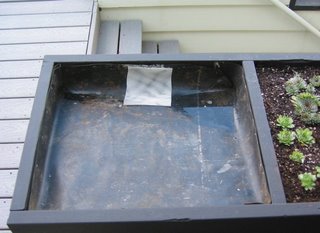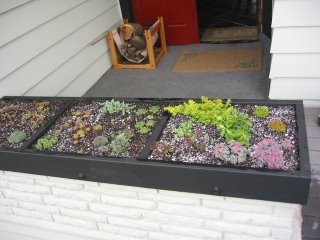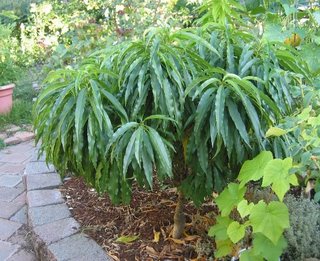Monday, September 18, 2006
Dog fun in the grass
 They like running around in the grass. Sometimes they nearly fly.
They like running around in the grass. Sometimes they nearly fly.With the rains starting now, the grass will green up soon.
Drove to work today. Still too tired from the last over-night shift, and the back was hurting.
I did remember to take clothes and some food for tomorrow.
Exact miles, work door to house front door: 9.6 miles.

Sunday, September 17, 2006
One day's harvest
 One day of harvest. Plus a half-pound of Chinese chive for dumplings. Not bad for a small yard.
One day of harvest. Plus a half-pound of Chinese chive for dumplings. Not bad for a small yard.Still tired; last night was an all-nighter at work, no breaks. Slept 1/2 of today.
Small back spasm, more due to being tired than anything that I did, so will drive tomorrow. Will bring clothes to work for anticipated bike ride on Tuesday.

Saturday, September 16, 2006
Sempervivum & Sedum "roof" project

This view shows an individual compartment, lined with recycled pond liner. The white area is a plastic mesh cover, made from a used mesh bag (that originally contained garden bulbs). The mesh covers the pipe outlet. The bottom of the box slopes about 1 inch per foot, toward the drain. The pipe is the only item specifically purchased so far for this project, 3/4" inside diameter rubber tube (about $1.75 for the entire length).

Close up of drain arrangement. The white plastic mesh was stapled to the side of the box so that it would not move around. The plastic pond liner is stretched around the end of the pipe.

After adding growth medium. The growth medium is "Whitney's organic potting soil", lightened with about 25% perlite for better drainage. After exploring the plant options, sedum was used in addition to sempervivum. About 1/2 of the plants were scrounged from around the yard, mainly Sempervivums that have multiplied and spread in several locations, and needed thinning, and Sedums that have been used for ground cover in dry locations. The other 1/2 were from end-of-summer sale at Portland Nursery. This view is from the stairway. Coming up the stairs, the plants can be viewed at eye-level.

Viewed from front door. My only real concern is that this is on the North side of the house, and the succulents may not flourish there. I think they will do OK, since there are already some at ground level on the North side of the house and North of a large tree.
This project is inspired by various green roof articles, such as a university site from Michigan, a do-it-yourself garage roof (with nice photos), a do-it-yourself roof in Vancouver Canada, and some sites in the UK. Even though it is the top of a small wall, it actually does serve as a small roof for a basement room, and the existing wall did leak into the basement. I'm hoping that with the pond liner and the drain system, the leakage will no longer occur, and that the plants will not require summer watering or other significant care.

Genetic Dwarf Peach "Garden Gold"

This "tree" is in its first bearing year, second year in this garden (but only 3 peaches). As with a lot of garden fruits, they taste more like one would expect from a peach, compared to the grocery store type. They are quite "peachy" and sweet.

The tree doesnt take up much space in the garden. Near it is a "Honey Babe" which is 5 years old, and is about 5 feet tall and 4 feet across at the top. It bore last year but not this year.

These trees are covered with pink flowers in the Spring. I keep saying that even if they dont have any peaches, they are worth it for their appearance. But I do want the peaches.
There is a good Mother Earth news article about these miniature trees. It has lost some of its formatting, but is still interesting to read. These trees are very dwarf, due to a loss of length of stem between nodes - instead of several inches between notes, there is only about a millimeter between nodes. They are said to be very high yielding - much more than the same amount of orchard space with larger trees.
The biggest hurdle to fruit, in this climate, is leaf curl. This disease strikes in Spring just after blooming. I tried a lime sulfur spray last winter and Spring, and it might have helpd some, but I think that the reason that there were so few fruits is that this disease strikes just when blossoms are setting. It may be possible to cover the trees during the winter to prevent this problem (I dont have faith in this approach) or a different (still organic) spray.

Subscribe to:
Comments (Atom)